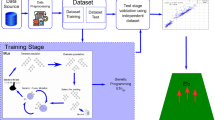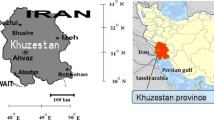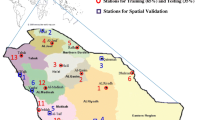Abstract
Reference evapotranspiration (ETo) is one of the foremost elements of the hydrology cycle which is essential for water resources management and irrigation applications. The current study is emphasized on the implementation of evolutionary computing models (i.e., gene expression programming (GEP)) for the simulation daily ETo in different locations of Peninsular Malaysia. The ETo models are developed using various input combinations of meteorological variables including air temperature (mean, maximum, and minimum), relative humidity, solar radiation, and mean wind speed. The in situ measurements of the ET are used to validate the model’s performance. The performance of the proposed GEP model is also compared with five well-established empirical formulations (EFs) developed based on the related climatological variability. The attained results evidenced the potential of GEP-derived ETo models in terms of all the statistical measures used. The best GEP model attained when all the meteorological variables are incorporated. However, the study revealed that the use of only temperature information can provide substantial predictability compared to EFs at all the studied stations across Peninsular Malaysia. This confirms the applicability of GEP in simulating ETo with fewer meteorological variables. The major advantage of GEP compared to other black box artificial intelligence algorithms is that GEP provides a set of equations which can be used by practitioners for reliable estimation of ETo at field with a fewer meteorological variable and, thus, can have wide applicability in water resources management.




Similar content being viewed by others
Data availability
Data are available with corresponding author.
Abbreviations
- AI:
-
Artificial intelligence
- AIC:
-
Akaike information criterion
- ETo:
-
Reference evapotranspiration
- GEP:
-
Gene expression programming
- EFs:
-
empirical formulations
- PM:
-
Penman-Monteith
- ANN:
-
Artificial neural network
- SVM:
-
Support vector machine
- GP:
-
Genetic programming
- ANFIS:
-
Adaptive neuro fuzzy inference system
- HS:
-
Hargreaves-Samani
- MK:
-
Makkink
- TR:
-
Turc
- PT:
-
Priestley-Taylor
- Tmax:
-
Temperature maximum
- Tmean:
-
Temperature mean
- Tmin:
-
Temperature minimum
- RH:
-
Relative humidity
- SR:
-
Solar radiation
- WS:
-
Mean wind speed
- MMD:
-
Malaysia Meteorological Department
- GA:
-
Genetic algorithms
- T:
-
Air temperature
- Sh:
-
Sunshine
- ST:
-
Soil temperature
- RH:
-
Relative humidity
- VP:
-
Vapor pressure
- WD:
-
Wind direction
- RF:
-
Rainfall
- EPR:
-
Evolutionary polynomial regression
- GP:
-
Genetic programming
- NR:
-
Net radiation
- EC-LE:
-
Eddy-covariance-measured latent heat
- ANFIS-GP and ANFIS-SC:
-
Adaptive neuro-fuzzy inference system integrated with grid partition and subtractive clustering
- EC-AET:
-
Eddy covariance-measured actual evapotranspiration
- WA-SVR:
-
Wavelet-support vector regression
- SVR-FFA:
-
Support vector regression-firefly algorithm
- MLR:
-
Multiple linear regression
- MARS:
-
Multivariate adaptive regression spline
- BT:
-
Boosted regression tree
- RFM:
-
Random forest model
- MT:
-
Model tree
- ELM:
-
Extreme learning machine
- DE:
-
Differential evolution
- NN-GP:
-
Neuro-fuzzy-grid partitioning
- NN-SC:
-
Neuro-fuzzy-sub-clustering
- CART:
-
Classification and regression tree
References
Adnan RM, Heddam S, Yaseen ZM et al (2021) Prediction of potential evapotranspiration using temperature-based heuristic approaches. Sustainability 13:297
Akaike H (1978) On the likelihood of a time series model. J R Stat Soc Ser D Stat 27:217–235
Alazba AA, Yassin MA, Mattar MA (2016) Modeling daily evapotranspiration in hyper-arid environment using gene expression programming. Arab J Geosci 9. https://doi.org/10.1007/s12517-015-2273-x
Alizamir M, Kisi O, Muhammad Adnan R, Kuriqi A (2020) Modelling reference evapotranspiration by combining neuro-fuzzy and evolutionary strategies. Acta Geophys 68:1113–1126. https://doi.org/10.1007/s11600-020-00446-9
Allen RG, Luis SP, RAES D, Smith M (1998) FAO irrigation and drainage paper No. 56. crop evapotranspiration (guidelines for computing crop water requirements). Irrig Drain. https://doi.org/10.1016/j.eja.2010.12.001
Bǎutu E, Bäutu A, Luchian H (2005) Symbolic regression on noisy data with genetic and gene expression programming. In: Proceedings - seventh international symposium on symbolic and numeric algorithms for scientific computing, SYNASC 2005. In
Chai T, Draxler RR (2014) Root mean square error (RMSE) or mean absolute error (MAE)? -Arguments against avoiding RMSE in the literature. Geosci Model Dev 7:1247–1250. https://doi.org/10.5194/gmd-7-1247-2014
Cobaner M (2011) Evapotranspiration estimation by two different neuro-fuzzy inference systems. J Hydrol 398:292–302. https://doi.org/10.1016/j.jhydrol.2010.12.030
Dávila-Jiménez MM, Elizalde-González MP, García-Díaz E, González-Perea M, Guevara-Villa MRG (2014) Using Akaike information criterion to select the optimal isotherm equation for adsorption from solution. Adsorpt Sci Technol 32:605–622. https://doi.org/10.1260/0263-6174.32.7.605
Djaman K, Balde AB, Sow A, Muller B, Irmak S, N’Diaye MK, Manneh B, Moukoumbi YD, Futakuchi K, Saito K (2015) Evaluation of sixteen reference evapotranspiration methods under sahelian conditions in the Senegal River valley. J Hydrol Reg Stud 3:139–159. https://doi.org/10.1016/j.ejrh.2015.02.002
Djamila H, Chu C, Kumaresan S (2014) Effect of humidity on thermal comfort in the humid tropics. J Build Constr Plan Res 5:1025–1036. https://doi.org/10.3390/buildings5031025
El-Baroudy I, Elshorbagy A, Carey SK et al (2010) Comparison of three data-driven techniques in modelling the evapotranspiration process. J Hydroinf 12:365–379
Fahimi F, Yaseen ZM, El-shafie A (2017) Application of soft computing based hybrid models in hydrological variables modeling: a comprehensive review. Theor Appl Climatol 128:875–903. https://doi.org/10.1007/s00704-016-1735-8
Fernando DAK, Shamseldin AY, Abrahart RJ (2009) Using gene expression programming to develop a combined runoff estimate model from conventional rainfall-runoff model outputs. In: 18th World IMACS congress and MODSIM09 international congress on modelling and simulation: interfacing modelling and simulation with mathematical and computational sciences, Proceedings
Ferreira C (2006) The Entities of Gene Expression Programming. In: Gene expression programming: mathematical modeling by an artificial intelligence. Springer
Ferreira C (2011) Gene expression programming in problem solving. Soft computing and industry, In
Fisher JB, Malhi Y, Bonal D et al (2009) The land-atmosphere water flux in the tropics. Glob Chang Biol 15:2694–2714. https://doi.org/10.1111/j.1365-2486.2008.01813.x
Gavilán P, Lorite IJ, Tornero S, Berengena J (2006) Regional calibration of Hargreaves equation for estimating reference et in a semiarid environment. Agric Water Manag 81:257–281. https://doi.org/10.1016/j.agwat.2005.05.001
Gocić M, Motamedi S, Shamshirband S, Petković D, Ch S, Hashim R, Arif M (2015a) Soft computing approaches for forecasting reference evapotranspiration. Comput Electron Agric 113:164–173. https://doi.org/10.1016/j.compag.2015.02.010
Gocić M, Motamedi S, Shamshirband S, Petković D, Ch S, Hashim R, Arif M (2015b) Soft computing approaches for forecasting reference evapotranspiration. Comput Electron Agric 113:164–173. https://doi.org/10.1016/j.compag.2015.02.010
Guven A, Aytek A, Yuce MI, Aksoy H (2008) Genetic programming-based empirical model for daily reference evapotranspiration estimation. Clean - Soil, Air, Water 36:905–912. https://doi.org/10.1002/clen.200800009
Guven A, Asce M, Aytek A (2009) New approach for stage – discharge relationship : gene-expression programming. J Hydrol Eng 14:812–820
Izadifar Z, Elshorbagy A (2010) Prediction of hourly actual evapotranspiration using neural networks, genetic programming, and statistical models. Hydrol Process 24:3413–3425. https://doi.org/10.1002/hyp.7771
Jaber HS, Mansor S, Pradhan B, Ahmad N (2016) Rainfall–runoff modelling and water balance analysis for Al-Hindiyah barrage, Iraq using remote sensing and GIS. Geocarto Int 32:1407–1420. https://doi.org/10.1080/10106049.2016.1213889
Jensen ME, Burman RD, Allen RG (1990) Evapotranspiration and irrigation water requirements. ASCE
Jing W, Yaseen ZM, Shahid S, Saggi MK, Tao H, Kisi O, Salih SQ, al-Ansari N, Chau KW (2019) Implementation of evolutionary computing models for reference evapotranspiration modeling: short review, assessment and possible future research directions. Eng Appl Comput Fluid Mech 13:811–823. https://doi.org/10.1080/19942060.2019.1645045
Jovic S, Nedeljkovic B, Golubovic Z, Kostic N (2018) Evolutionary algorithm for reference evapotranspiration analysis. Comput Electron Agric 150:1–4. https://doi.org/10.1016/j.compag.2018.04.003
Kazemi MH, Majnooni-heris A, Kisi O, Shiri J (2020) Generalized gene expression programming models for estimating reference evapotranspiration through cross-station assessment and exogenous data supply
Khan N, Pour SH, Shahid S, Ismail T, Ahmed K, Chung ES, Nawaz N, Wang X (2019) Spatial distribution of secular trends in rainfall indices of Peninsular Malaysia in the presence of long-term persistence. Meteorol Appl 26:655–670. https://doi.org/10.1002/met.1792
Kiafar H, Babazadeh H, Marti P, Kisi O, Landeras G, Karimi S, Shiri J (2017a) Evaluating the generalizability of GEP models for estimating reference evapotranspiration in distant humid and arid locations. Theor Appl Climatol 130:377–389. https://doi.org/10.1007/s00704-016-1888-5
Kiafar H, Babazadeh H, Marti P, Kisi O, Landeras G, Karimi S, Shiri J (2017b) Evaluating the generalizability of GEP models for estimating reference evapotranspiration in distant humid and arid locations. Theor Appl Climatol 130:377–389. https://doi.org/10.1007/s00704-016-1888-5
Kisi O (2010) Modeling reference evapotranspiration using evolutionary neural networks. J Irrig Drain Eng 137:636–643. https://doi.org/10.1061/(asce)ir.1943-4774.0000333
Kisi O, Sanikhani H, Zounemat-Kermani M, Niazi F (2015) Long-term monthly evapotranspiration modeling by several data-driven methods without climatic data. Comput Electron Agric 115:66–77. https://doi.org/10.1016/j.compag.2015.04.015
Koza JR (1992) Genetic programming: on the programming of computers by means of natural selection. MIT press
Kumar M, Raghuwanshi NS, Singh R (2011) Artificial neural networks approach in evapotranspiration modeling: A review. Irrig Sci 29:11–25
Lee TS, Najim MMM, Aminul MH (2004) Estimating evapotranspiration of irrigated rice at the West Coast of the Peninsular of Malaysia
Legates DR, Mccabe GJ (1999) Evaluating the use of “goodness-of-fit” measures in hydrologic and hydroclimatic model validation. Water Resour Res 35:233–241
Martí P, González-Altozano P, López-Urrea R, Mancha LA, Shiri J (2015) Modeling reference evapotranspiration with calculated targets. Assessment and implications. Agric Water Manag 149:81–90. https://doi.org/10.1016/j.agwat.2014.10.028
Mattar MA (2018) Using gene expression programming in monthly reference evapotranspiration modeling: a case study in Egypt. Agric Water Manag 198:28–38. https://doi.org/10.1016/j.agwat.2017.12.017
Mattar MA, Alazba AA (2018) GEP and MLR approaches for the prediction of reference evapotranspiration. Neural Comput & Applic:1–13
Mattar MA, Alazba AA, Alblewi B, Gharabaghi B, Yassin MA (2016) Evaluating and calibrating reference evapotranspiration models using water balance under hyper-arid environment. Water Resour Manag 30:3745–3767. https://doi.org/10.1007/s11269-016-1382-y
Mayowa OO, Pour SH, Shahid S, Mohsenipour M, Harun SB, Heryansyah A, Ismail T (2015) Trends in rainfall and rainfall-related extremes in the east coast of peninsular Malaysia. Journal of Earth System Science 124(8):1609–1622
Mehdizadeh S (2018) Estimation of daily reference evapotranspiration (ETo) using artificial intelligence methods: offering a new approach for lagged ETo data-based modeling. J Hydrol 559:794–812. https://doi.org/10.1016/J.JHYDROL.2018.02.060
Mehdizadeh S, Behmanesh J, Khalili K (2017) Using MARS, SVM, GEP and empirical equations for estimation of monthly mean reference evapotranspiration. Comput Electron Agric 139:103–114. https://doi.org/10.1016/j.compag.2017.05.002
Mohsenipour M, Shahid S, sung CE, jun WX (2018) Changing pattern of droughts during cropping seasons of Bangladesh. Water Resour Manag 32:1555–1568. https://doi.org/10.1007/s11269-017-1890-4
Naganna SR, Beyaztas BH, Bokde N, Armanuos AM (2020) On the evaluation of the gradient tree boosting model for groundwater level forecastinG. Knowledge-Based Eng Sci 1:48–57
Parasuraman K, Elshorbagy A, Carey SK (2007) Modelling the dynamics of the evapotranspiration process using genetic programming. Hydrol Sci J 52:563–578. https://doi.org/10.1623/hysj.52.3.563
Pour SH, Abd Wahab AK, Shahid S, Wang X (2019) Spatial pattern of the unidirectional trends in thermal bioclimatic indicators in Iran. Sustainability 11:2287. https://doi.org/10.3390/su11082287
Rana G, Katerji N (2000a) Measurement and estimation of actual evapotranspiration in the field under Mediterranean climate: a review. European Journal of Agronomy, In, pp 125–153
Rana G, Katerji N (2000b) Measurement and estimation of actual evapotranspiration in the field under Mediterranean climate: a review. Eur J Agron 13:125–153. https://doi.org/10.1016/S1161-0301(00)00070-8
Roudier P, Ducharne A, Feyen L (2014) Climate change impacts on runoff in West Africa: a review. Hydrol Earth Syst Sci 18:2789–2801
Roy DK, Barzegar R, Quilty J, Adamowski J (2020) Using ensembles of adaptive neuro-fuzzy inference system and optimization algorithms to predict reference evapotranspiration in subtropical climatic zones. J Hydrol 591:125509. https://doi.org/10.1016/j.jhydrol.2020.125509
Sakamoto Y, Ishiguro M, Kitagawa G (1986) Akaike information criterion statistics. Dordrecht, Netherlands D Reidel 81
Salem GSA, Kazama S, Shahid S, Dey NC (2017) Impact of temperature changes on groundwater levels and irrigation costs in a groundwater-dependent agricultural region in Northwest Bangladesh. Hydrol Res Lett 11:85–91. https://doi.org/10.3178/hrl.11.85
Salman SA, Shahid S, Ismail T, Chung ES, al-Abadi AM (2017) Long-term trends in daily temperature extremes in Iraq. Atmos Res 198:97–107. https://doi.org/10.1016/j.atmosres.2017.08.011
Sanikhani H, Kisi O, Maroufpoor E, Yaseen ZM (2018) Temperature-based modeling of reference evapotranspiration using several artificial intelligence models: application of different modeling scenarios. Theor Appl Climatol 0 135:449–462. https://doi.org/10.1007/s00704-018-2390-z
Sayl KN, Muhammad NS, Yaseen ZM, El-shafie A (2016) Estimation the physical variables of rainwater harvesting system using integrated GIS-based remote sensing approach. Water Resour Manag 30:3299–3313. https://doi.org/10.1007/s11269-016-1350-6
Sentelhas PC, Gillespie TJ, Santos EA (2010) Evaluation of FAO Penman-Monteith and alternative methods for estimating reference evapotranspiration with missing data in Southern Ontario. Canada Agric Water Manag doi 97:635–644. https://doi.org/10.1016/j.agwat.2009.12.001
Shahid S (2011) Impact of climate change on irrigation water demand of dry season Boro rice in northwest Bangladesh. Clim Chang 105:433–453. https://doi.org/10.1007/s10584-010-9895-5
Shahid S, Pour SH, Wang X, Shourav SA, Minhans A, Ismail T (2017) Impacts and adaptation to climate change in Malaysian real estate. Int J Clim Chang Strateg Manag 9:87–103. https://doi.org/10.1108/IJCCSM-01-2016-0001
Shiri J (2019) Modeling reference evapotranspiration in island environments: assessing the practical implications. J Hydrol 570:265–280. https://doi.org/10.1016/j.jhydrol.2018.12.068
Shiri J, Kişi Ö, Landeras G, López JJ, Nazemi AH, Stuyt LCPM (2012a) Daily reference evapotranspiration modeling by using genetic programming approach in the Basque Country (Northern Spain). J Hydrol 414–415:302–316. https://doi.org/10.1016/j.jhydrol.2011.11.004
Shiri J, Kişi Ö, Landeras G, López JJ, Nazemi AH, Stuyt LCPM (2012b) Daily reference evapotranspiration modeling by using genetic programming approach in the Basque Country (Northern Spain). J Hydrol 414–415:302–316. https://doi.org/10.1016/j.jhydrol.2011.11.004
Shiri J, Nazemi AH, Sadraddini AA, Landeras G, Kisi O, Fard AF, Marti P (2013a) Global cross-station assessment of neuro-fuzzy models for estimating daily reference evapotranspiration. J Hydrol 480:46–57. https://doi.org/10.1016/j.jhydrol.2012.12.006
Shiri J, Sadraddini AA, Nazemi AH, Kisi O, Marti P, Fard AF, Landeras G (2013b) Evaluation of different data management scenarios for estimating daily reference evapotranspiration. Hydrol Res 44:1058–1070. https://doi.org/10.2166/nh.2013.154
Shiri J, Nazemi AH, Sadraddini AA, Landeras G, Kisi O, Fakheri Fard A, Marti P (2014a) Comparison of heuristic and empirical approaches for estimating reference evapotranspiration from limited inputs in Iran. Comput Electron Agric 108:230–241. https://doi.org/10.1016/j.compag.2014.08.007
Shiri J, Sadraddini AA, Nazemi AH, Kisi O, Landeras G, Fakheri Fard A, Marti P (2014b) Generalizability of gene expression programming-based approaches for estimating daily reference evapotranspiration in coastal stations of Iran. J Hydrol 508:1–11. https://doi.org/10.1016/j.jhydrol.2013.10.034
Shiri J, Marti P, Karimi S, Landeras G (2019) Data splitting strategies for improving data driven models for reference evapotranspiration estimation among similar stations. Comput Electron Agric 162:70–81. https://doi.org/10.1016/j.compag.2019.03.030
Shiri J, Zounemat-Kermani M, Kisi O, Mohsenzadeh Karimi S (2020) Comprehensive assessment of 12 soft computing approaches for modelling reference evapotranspiration in humid locations. Meteorol Appl 27. https://doi.org/10.1002/met.1841
Shiru MS, Shahid S, Alias N, Chung ES (2018) Trend analysis of droughts during crop growing seasons of Nigeria. Sustain 10:1–13. https://doi.org/10.3390/su10030871
Sun Y, Li Z, Tang C et al (2009) An evolving neural network for authentic emotion classification. In: 2009 Fifth International Conference on Natural Computation. IEEE, pp 109–113
Tao H, Diop L, Bodian A et al (2018) Reference evapotranspiration prediction using hybridized fuzzy model with firefly algorithm: regional case study in Burkina Faso. Agric Water Manag
Traore S, Guven A (2012) Regional-specific numerical models of evapotranspiration using gene-expression programming interface in Sahel. Water Resour Manag 26:4367–4380. https://doi.org/10.1007/s11269-012-0149-3
Traore S, Guven A (2013) New algebraic formulations of evapotranspiration extracted from gene-expression programming in the tropical seasonally dry regions of West Africa. Irrig Sci 31:1–10. https://doi.org/10.1007/s00271-011-0288-y
Traore S, Luo Y, Fipps G (2017) Gene-expression programming for short-term forecasting of daily reference evapotranspiration using public weather forecast information. Water Resour Manag 31:4891–4908. https://doi.org/10.1007/s11269-017-1784-5
Tukimat NNA, Harun S, Shahid S (2012) Comparison of different methods in estimating potential evapotranspiration at Muda irrigation scheme of Malaysia. J Agric Rural Dev Trop Subtrop 113:77–85
Valiantzas JD (2018) Temperature-and humidity-based simplified Penman’s ET0 formulae. Comparisons with temperature-based Hargreaves-Samani and other methodologies. Agric Water Manag 208:326–334. https://doi.org/10.1016/j.agwat.2018.06.028
Valipour M, Gholami Sefidkouhi MA, Raeini-Sarjaz M (2020) Spatiotemporal analysis of reference evapotranspiration in Arid, Semiarid, Mediterranean and Very humid climates considering developed models and lysimeter measurements. Water Conserv Sci Eng 5:81–96. https://doi.org/10.1007/s41101-020-00087-5
Wang X-J, Zhang J-Y, Shahid S, Guan EH, Wu YX, Gao J, He RM (2016) Adaptation to climate change impacts on water demand. Mitig Adapt Strateg Glob Chang 21:81–99. https://doi.org/10.1007/s11027-014-9571-6
Wigmosta MS, Vail LW, Lettenmaier DP (1994) A distributed hydrology-vegetation model for complex terrain. Water Resour Res 30:1665–1679. https://doi.org/10.1029/94WR00436
Yao Y, Liang S, Li X, Chen J, Liu S, Jia K, Zhang X, Xiao Z, Fisher JB, Mu Q, Pan M, Liu M, Cheng J, Jiang B, Xie X, Grünwald T, Bernhofer C, Roupsard O (2017) Improving global terrestrial evapotranspiration estimation using support vector machine by integrating three process-based algorithms. Agric For Meteorol 242:55–74. https://doi.org/10.1016/j.agrformet.2017.04.011
Yaseen ZM, Ghareb MI, Ebtehaj I et al (2017) Rainfall pattern forecasting using novel hybrid intelligent model based ANFIS-FFA. Water Resour Manag
Yassin MA, Alazba AA, Mattar MA (2016a) Artificial neural networks versus gene expression programming for estimating reference evapotranspiration in arid climate. Agric Water Manag 163:110–124. https://doi.org/10.1016/j.agwat.2015.09.009
Yassin MA, Alazba AA, Mattar MA (2016b) Comparison between gene expression programming and traditional models for estimating evapotranspiration under hyper arid conditions 1. Water Res 43:412–427. https://doi.org/10.1134/S0097807816020172
Zuo J, Tang C, Li C, et al (2004) Time series prediction based on gene expression programming. In: advances in web-age information management: 5th International Conference, WAIM 2004
Code availability
Modeling is performed using GeneXproTools software.
Author information
Authors and Affiliations
Contributions
Mohd Khairul Idlan Muhammad: modeling, conceptualization, writing up the manuscript. Shamsuddin Shahid: supervision, writing up the manuscript, conceptualization, data analysis. Tarmizi Ismail: supervision, writing up the manuscript, conceptualization, data analysis. Sobri Harun: supervision, conceptualization, writing up the manuscript, data analysis. Ozgur Kisi: validation, investigation, revision, manuscript editing. Zaher Mundher Yaseen: results analysis and discussion, writing up the manuscript, visualization, investigation.
Corresponding author
Ethics declarations
Ethics approval
The manuscript is conducted within the ethical manner advised by the Theoretical and Applied Climatology.
Consent to participate
Not applicable.
Consent for publication
The research is scientifically consent to be published.
Conflict of interest
The authors declare no competing interests.
Additional information
Publisher’s note
Springer Nature remains neutral with regard to jurisdictional claims in published maps and institutional affiliations.
Rights and permissions
About this article
Cite this article
Muhammad, M.K.I., Shahid, S., Ismail, T. et al. The development of evolutionary computing model for simulating reference evapotranspiration over Peninsular Malaysia. Theor Appl Climatol 144, 1419–1434 (2021). https://doi.org/10.1007/s00704-021-03606-z
Received:
Accepted:
Published:
Issue Date:
DOI: https://doi.org/10.1007/s00704-021-03606-z




